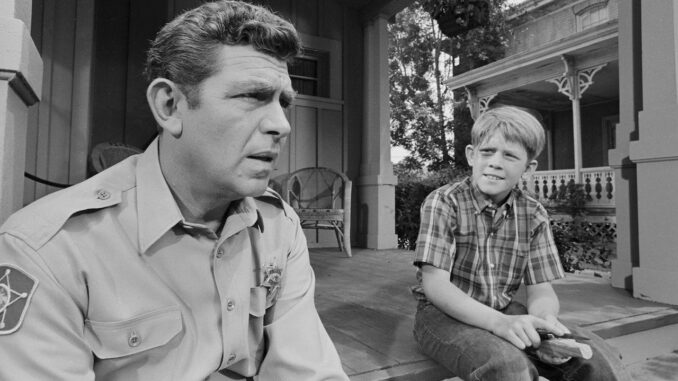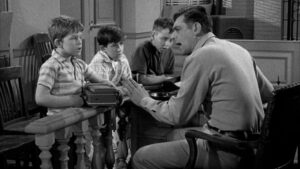
Andy Griffith Show Refused to Have a Three-Camera Format on His Show: ‘The Audience Is What Creates the Problem’
The Andy Griffith Show is widely regarded as one of the most iconic television series of all time. From its charming characters to its witty humor, the show captured the hearts of viewers across America. But did you know there was one unique production decision that set it apart from most other sitcoms of its time? The show famously refused to use the popular three-camera format that was standard for many sitcoms. Andy Griffith himself had strong opinions on this decision, and it became a defining feature of the show’s production style.
In this article, we’ll delve into why Andy Griffith turned down the three-camera format, the impact this decision had on the show, and how it ultimately contributed to the show’s timeless appeal.
The Three-Camera Format: A Television Standard
Before we get into why Andy Griffith rejected this format, let’s first understand what the three-camera setup is and why it became so popular in the first place.
The three-camera format is a multi-camera setup that allows for simultaneous filming of different angles during a live performance or a sitcom shoot. The benefit of this approach was clear: it allowed for faster production times, captured more dynamic shots, and provided a live audience with an interactive experience. Shows like I Love Lucy and The Mary Tyler Moore Show popularized this method, and it became the go-to for most television sitcoms.
However, Andy Griffith had a very different vision for his show.
Why Did Andy Griffith Reject the Three-Camera Setup?
Andy Griffith was known for his attention to detail and his commitment to creating a specific atmosphere on set. He was a perfectionist who believed that the three-camera format didn’t align with his vision for The Andy Griffith Show. Griffith was particularly concerned with the live studio audience’s involvement in the process.
The Problem with the Audience: Griffith’s Perspective
Griffith believed that the audience’s presence, while vital for shows using the three-camera format, could be distracting and sometimes even counterproductive. He felt that the laughs and reactions from the audience were too forced, detracting from the organic nature of the show. In his view, the audience’s laughter should come naturally, not at the cue of a camera switch or sound effects.
The show’s producers agreed with Griffith’s viewpoint. They wanted to maintain the charm of the rural, homey setting without the influence of artificial laughter or forced reactions. Griffith was insistent that the audience’s involvement shouldn’t dictate the pacing or tone of the show.

The Single-Camera Format: A Bold Choice for Authenticity
Instead of the three-camera format, The Andy Griffith Show used a single-camera setup. This choice allowed for more control over the pace of the show and provided the opportunity to film scenes in a more cinematic, less “staged” manner. It also gave Griffith and the other actors more freedom to deliver their lines without the pressure of immediate audience reactions.
Emphasizing Story Over Reaction
Griffith’s decision was groundbreaking at the time. By rejecting the three-camera approach, he was putting more emphasis on storytelling, character development, and visual composition rather than quick gags or audience-triggered laughs. This made the show feel more like a movie than a traditional sitcom, where scenes could be carefully framed and edited for optimal storytelling.
For the viewers, this created a more immersive experience. They weren’t distracted by the artificial cues from a live audience. Instead, they were drawn into the world of Mayberry, experiencing the lives of Andy, Barney, Aunt Bee, and Opie in a way that felt natural and unforced.
How the Single-Camera Format Changed Sitcom Production
At the time, the single-camera format was far less common for sitcoms. Shows like The Twilight Zone and Leave It to Beaver used similar approaches, but the three-camera format dominated the sitcom genre. Andy Griffith’s decision to opt for a single-camera setup was a risk, but it paid off in ways that would influence television for years to come.
Better Cinematic Quality
The single-camera format allowed the show to be filmed with greater visual depth. Directors could focus on creating beautiful shots, using angles and lighting to add emotional weight to the scenes. This gave The Andy Griffith Show its signature style, one that looked and felt different from the typical sitcoms of the time.
More Freedom for the Actors
Without the constraints of a live studio audience, the actors had the freedom to explore their characters in a more nuanced way. They could play off each other without worrying about the timing required for a three-camera setup. This led to more authentic performances, making the characters even more beloved by audiences.
The Impact on Audience Engagement
One might assume that the lack of a live audience would lead to a loss of energy on set, but The Andy Griffith Show proved otherwise. The absence of artificial laughter allowed the show’s humor to emerge from the dialogue and situations, rather than relying on external cues. The result was a more subtle and genuine form of comedy that resonated deeply with viewers.
The quieter, more natural pacing of the show allowed audiences to focus on the characters and their interactions rather than waiting for the next laugh track. This created a deeper emotional connection to the characters, making their triumphs and tribulations all the more impactful.
Griffith’s Legacy: A Pioneer of Storytelling in Sitcoms
Andy Griffith’s decision to avoid the three-camera format is just one example of how he redefined what it meant to produce a sitcom. By rejecting the industry standard, he created a show that stood out from the pack. His commitment to storytelling over gimmicks has influenced countless sitcoms and dramas in the decades since.
Griffith’s Legacy in Modern Television
Today, many successful shows, such as The Office and Parks and Recreation, follow in Griffith’s footsteps with their single-camera approach. These shows emphasize character-driven humor and storytelling over laugh tracks or studio audiences, much like Griffith’s Mayberry.
A Final Word on the Andy Griffith Show’s Production Choices
In the end, Andy Griffith’s decision to reject the three-camera format helped The Andy Griffith Show stand the test of time. The show’s authenticity, grounded humor, and loveable characters remain a source of inspiration for television creators today.
Griffith’s reluctance to conform to the norms of his time proved that sometimes, breaking the mold is exactly what a show needs to make a lasting impact.
Conclusion: Why It Was the Right Move for Andy Griffith
Andy Griffith’s refusal to follow the three-camera format was a bold move that helped define the unique charm of The Andy Griffith Show. His commitment to a single-camera setup allowed for more authentic performances, better visual storytelling, and a deeper connection with the audience. By rejecting industry conventions, Griffith created a show that felt personal and real, contributing to its enduring legacy as one of the greatest sitcoms of all time.
FAQs
1. Why didn’t Andy Griffith use a three-camera format on his show?
Andy Griffith felt that the audience’s involvement in the production process, typical of the three-camera format, created a forced atmosphere. He wanted the show to feel more natural and less dependent on artificial cues.
2. How did the single-camera format impact The Andy Griffith Show?
The single-camera format allowed for more cinematic visuals, better control over pacing, and more authentic performances from the cast, making the show feel less staged.
3. Was the single-camera approach unusual at the time?
Yes, the three-camera format was the standard for sitcoms in the 1960s, making Griffith’s decision to use a single-camera setup a bold and unconventional choice.
4. Did the lack of a live audience affect the show’s humor?
No, in fact, the absence of a live audience allowed the humor to emerge more naturally from the dialogue and situations, rather than relying on laughter cues.
5. How has Griffith’s decision influenced modern sitcoms?
Many modern sitcoms, like The Office and Parks and Recreation, follow a similar single-camera format, emphasizing character-driven humor and subtle comedy over laugh tracks and studio audiences.
